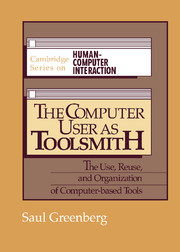Book contents
- Frontmatter
- Contents
- List of figures
- List of tables
- Foreword
- Acknowledgments and dedication
- 1 Introduction
- 2 Studying UNIX
- 3 Using commands in UNIX
- 4 Techniques for reusing activities
- 5 Recurrent systems
- 6 Reuse opportunities in UNIX csh – potential and actual
- 7 Principles, corroboration, and justification
- 8 Organizing activities through workspaces
- 9 A workspace system: description and issues
- 10 Conclusion
- Appendix A A sample trace
- Appendix B Summary statistics for each subject
- References
- Author index
- Subject index
Foreword
Published online by Cambridge University Press: 26 May 2010
- Frontmatter
- Contents
- List of figures
- List of tables
- Foreword
- Acknowledgments and dedication
- 1 Introduction
- 2 Studying UNIX
- 3 Using commands in UNIX
- 4 Techniques for reusing activities
- 5 Recurrent systems
- 6 Reuse opportunities in UNIX csh – potential and actual
- 7 Principles, corroboration, and justification
- 8 Organizing activities through workspaces
- 9 A workspace system: description and issues
- 10 Conclusion
- Appendix A A sample trace
- Appendix B Summary statistics for each subject
- References
- Author index
- Subject index
Summary
Humans are the most versatile of creatures, and computers are their most versatile of creations. Human–Computer Interaction (HCI) is the study of what they do together; in particular, HCI aims to make interaction better suit the humans. Computers contribute to art, science, engineering, … all areas of human endeavor. It is no surprise, then, that there is heated debate about what the essence of HCI is and what it should be. What is good HCI? The answer to this question will be elusive given that there is good engineering that is not art, good art that is not science, and good science that is not engineering.
It's easier to see what form of answer there can be by taking a quick excursion into another field. Imagine the discovery of a dye, such as W. H. Perkin's breakthrough discovery of mauve. Is it science? Yes: certain chemicals must react to produce the dyestuff, and the principles of chemistry suggest other possibilities. Is it art? Yes: it makes an attractive color. Is it engineering? Yes: its quantity production, fastness in materials, and so forth, are engineering. Perkin's work made the once royal purple accessible to all. Fortunately there is no subject “Human Chemical Interaction” to slide us into thinking that there is, or should be, one right view of the work of making or using, designing, standardizing, or evaluating a dye. Nevertheless, we appreciate a readily available, stunning color, used by an able artist, and one that lasts without deteriorating.
- Type
- Chapter
- Information
- The Computer User as ToolsmithThe Use, Reuse and Organization of Computer-Based Tools, pp. xiii - xivPublisher: Cambridge University PressPrint publication year: 1993

